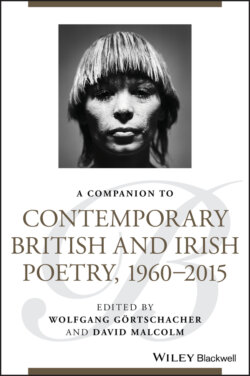Читать книгу A Companion to Contemporary British and Irish Poetry, 1960 - 2015 - Группа авторов - Страница 33
Mimi Khalvati, “Ghazal: The Servant” (2007) (Khalvati 2011, 21)
ОглавлениеThis poem announces its extraterritorial quality from the start. It is a ghazal, a Middle‐Eastern and Asian form (although it has been practiced in English). The text is addressed to “Ma'mad” (the informal Persian for Mohammed). The speaker refers to herself (such reference is traditional in a ghazal) as “Maryam.” The speaker is in some distress. There is a curfew. There is blood on the streets. The addressee is delayed. Children are missing. But this is a highly elliptical poem. The context and its outcome are unknown. This fragmentary quality contrasts with the text's extreme regularity. Each of the five stanzas has two lines followed by a refrain. Two eight‐syllable lines are followed by a four‐syllable one. Only lines 4, 10, and 14 deviate, and then only by one (possibly elided) syllable. Main stress placement is regular, and follows a 4‐4‐2 pattern. The refrain recurs. Rhymes are regular and predominantly full—“grows / flows / blows / throws / goes”—although there is deviancy in some rhymes—“rose” and “so,” and “flame” and “time.” Also “child” in stanza 5 lacks any rhyming word, and the refrain's “rain” matches nothing in the poem.
The poem aims at a non‐English experience—revolution, repression, danger—and does so through a relatively unfamiliar fixed form. The poem's sinister quality lies in its fragmentary quality, and in its not quite complete regularity. Although it is an exotic piece, it echoes traditional English ballads and folk songs, and the use of those traditional forms by Wordsworth, Stevie Smith, and James Fenton. Its focus on uncertainty, danger, and betrayal is not, of course, exotic, but is part of universal human experience. The ghazal invokes the ballad, and all that ballads are about.
